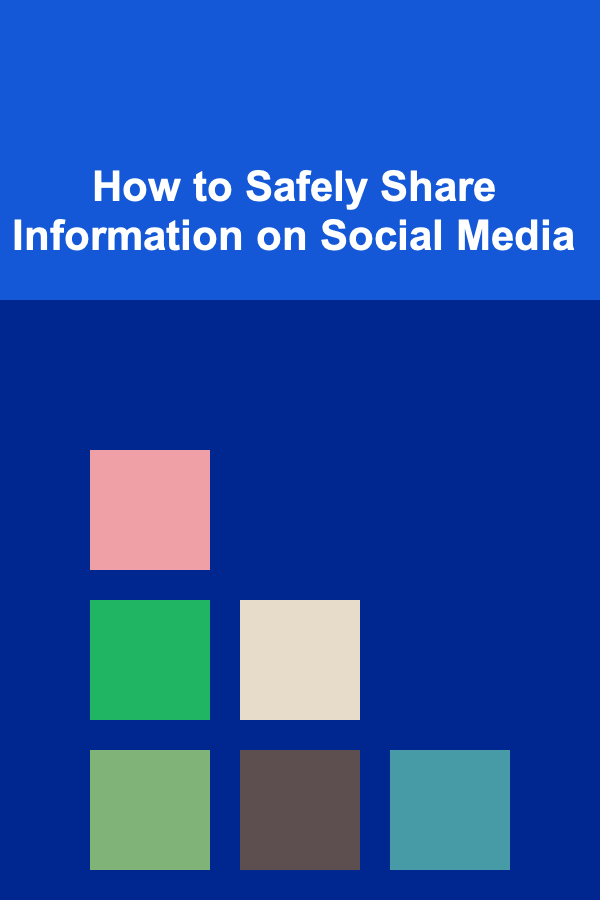
How to Safely Share Information on Social Media
ebook include PDF & Audio bundle (Micro Guide)
$12.99$8.99
Limited Time Offer! Order within the next:

In the modern world, social media has become an integral part of daily life. It provides a platform for connecting with friends, staying updated with the latest news, and sharing personal thoughts and experiences. However, while social media can offer many benefits, it also poses significant risks when it comes to privacy and security. The ease of sharing personal information online has created an environment where users are often unaware of the potential consequences of disclosing too much. In this article, we will explore the ways to safely share information on social media, balancing the need for self-expression with the protection of personal data.
Understanding the Risks of Sharing Information on Social Media
Before diving into strategies for safely sharing information, it's essential to first recognize the risks associated with social media usage. These risks range from identity theft to unwanted attention, and they can have lasting effects if personal information is shared recklessly.
1. Identity Theft and Fraud
One of the most significant risks associated with social media is identity theft. Cybercriminals can exploit the information users share, such as names, birthdays, addresses, and even location tags, to commit fraud. By piecing together small details, malicious actors can build a profile of an individual and use it for illegal purposes.
2. Privacy Violations
Most social media platforms collect and store vast amounts of personal data. Even if users set their profiles to private, there is always a chance that personal information will be accessed by unauthorized parties or sold to third parties. Privacy violations can occur even with the best intentions, and once personal data is exposed, it can be difficult to take it back.
3. Cyberbullying and Harassment
Sharing personal information, especially controversial opinions or images, can invite unwanted attention. Cyberbullying and online harassment are unfortunately common consequences of sharing personal details on social media. Individuals may become targets of hate, threats, or verbal abuse, which can have serious emotional and psychological effects.
4. Doxxing
Doxxing refers to the act of publishing private or identifying information about an individual without their consent. This can include addresses, phone numbers, workplace details, and other sensitive data. Doxxing is often used to intimidate or punish people, and it can result in real-world consequences, such as physical harm or job loss.
5. Reputation Damage
Sharing too much personal information or controversial content on social media can damage an individual's reputation. Whether it's a comment made in poor judgment or a photo that paints someone in a negative light, information shared online can be permanent and accessible to employers, friends, and others long after the post is made.
Best Practices for Safely Sharing Information
To protect yourself while using social media, it's crucial to implement strategies that help safeguard your privacy and personal data. By following best practices, you can reduce the risks and enjoy the benefits of social media without compromising your security.
1. Adjust Privacy Settings
One of the first steps to protecting your privacy on social media is adjusting your account's privacy settings. Most platforms allow you to control who can see your posts, your personal information, and even your friend list. Here are a few key settings to review:
- Profile Visibility: Make sure your profile is set to private or visible only to approved friends or followers. Avoid having your profile publicly accessible to strangers.
- Post Visibility: When posting content, check who can see it. Some platforms allow you to share posts with specific people or groups, ensuring that your information stays within a trusted circle.
- Location Settings: Disable location services on social media apps, or use them sparingly. Posting your real-time location can expose you to unnecessary risks, especially if you're sharing information about being at home or in a secluded area.
- Third-Party Apps and Permissions: Review the apps and websites that are connected to your social media accounts. Revoke access to any third-party applications that no longer serve a purpose or that you do not recognize.
2. Limit the Information You Share
Another key step in protecting yourself on social media is to limit the personal information you share. While it might be tempting to share your life story, doing so can leave you vulnerable to privacy breaches or exploitation. Keep the following guidelines in mind:
- Avoid Over-Sharing: It's tempting to post about every event or moment in your life, but consider whether the information you're sharing is necessary. Avoid posting sensitive details such as your full name, phone number, or home address.
- Think Before You Post: Before sharing anything, take a moment to consider the potential consequences. Would you be comfortable with the entire world seeing it? Would it be harmful if someone misinterpreted or misused the information?
- Be Cautious with Photos: Photos can reveal a lot more than just your appearance. Be mindful of background details, such as street signs, addresses, or other identifying features, that could inadvertently expose personal information.
3. Use Strong Passwords and Two-Factor Authentication
One of the simplest ways to protect your social media accounts from unauthorized access is by using strong, unique passwords for each platform. Avoid using easily guessable passwords such as "123456" or "password." Instead, use a combination of letters, numbers, and symbols, and aim for a length of at least 12 characters.
Additionally, enable two-factor authentication (2FA) whenever possible. This adds an extra layer of security by requiring a second form of identification, such as a code sent to your phone or email, in addition to your password.
4. Be Mindful of Third-Party Apps and Scams
Many social media platforms allow third-party apps to integrate with your account, but some of these apps can be malicious. Always check the permissions of any app before granting access to your account, and be wary of apps that ask for too much personal information.
Scammers often use social media to trick people into providing sensitive data. Be cautious of messages or posts that offer "too good to be true" deals, ask for personal information, or prompt you to click on unfamiliar links. Phishing attacks and scams are rampant on social media, and being vigilant can help protect your privacy.
5. Educate Yourself on Privacy Policies
While it may not be the most exciting task, it's important to read and understand the privacy policies of the social media platforms you use. These policies outline how your data is collected, used, and shared. They also provide insight into how the platform handles data breaches or security issues. Knowing the platform's practices allows you to make informed decisions about the data you share.
If a platform's privacy policy seems overly invasive or unclear, consider whether it's worth using. Opt for platforms that prioritize user privacy and provide robust security features.
6. Avoid Public Wi-Fi for Sensitive Activities
Using public Wi-Fi networks can expose your social media accounts and personal information to hackers. When connected to an unsecured Wi-Fi network, cybercriminals can potentially intercept your data and gain access to your social media accounts.
If you must use public Wi-Fi, avoid accessing sensitive information, such as logging into your social media accounts or banking apps. Instead, consider using a Virtual Private Network (VPN) to encrypt your connection and protect your data from potential threats.
7. Be Selective with Who You Accept as Friends or Followers
Building a network of trusted connections is crucial when it comes to maintaining your privacy on social media. Be selective about who you accept as a friend or follower. This is especially important on platforms like Facebook or LinkedIn, where personal and professional connections overlap.
- Know Your Audience: When sharing information, be aware of who will be able to view it. For example, if you're posting about a personal event, it's wise to limit visibility to close friends and family.
- Review Friend Lists Periodically: Over time, you may have accepted connection requests from people you no longer know or trust. Periodically review your friend and follower lists to ensure that only those you trust have access to your posts.
8. Monitor Your Digital Footprint
Your digital footprint is the trail of information you leave behind on the internet, and it's something that you should actively manage. Search for your name regularly to see what others can find about you online, and remove any unwanted or outdated content that might compromise your privacy.
Some social media platforms allow you to request the removal of certain information or deactivate your account entirely. If you're concerned about your digital footprint, take the necessary steps to clean up your online presence and minimize the data that's accessible to others.
Conclusion
Sharing information on social media is an inevitable part of modern life, but it's essential to approach it with caution and mindfulness. By adjusting privacy settings, limiting personal information, using strong passwords, and being cautious of third-party apps and scams, you can protect your privacy and enjoy a safer social media experience.
Remember, your digital footprint is something that should be carefully curated, and taking proactive steps to safeguard your personal information will help you mitigate the risks associated with social media. In the end, finding a balance between self-expression and privacy is key to navigating the ever-evolving landscape of social media securely.
Reading More From Our Other Websites
- [Organization Tip 101] How to Implement a Weekly Maintenance Routine for Your Bathroom Cabinet
- [Home Space Saving 101] How to Maximize Space in Tiny Living Spaces with Clever Hacks
- [Personal Care Tips 101] How to Do DIY Face Masks for Sensitive Skin
- [Home Pet Care 101] How to Create a Pet-Friendly Home on a Budget
- [Organization Tip 101] How to Use Technology Mindfully in Your Daily Life
- [Home Staging 101] How to Stage on a Budget: Your Go-To Guide for Staging with Rental Furniture
- [Gardening 101] Why You Should Choose Native Plants for Your Garden
- [Personal Care Tips 101] How to Make Your Perfume Scent Last Through Exercise
- [Survival Kit 101] Emergency Survival Kit for Kids with Asthma: A Parent's Guide to Peace of Mind
- [Personal Care Tips 101] How to Use Makeup Primer for Creating an Even Skin Tone

How to Clean and Maintain Your Home's Kitchen Exhaust Fan
Read More
How To Master Public Speaking for Introverts
Read More
How to Organize a Family Picnic in Your Backyard
Read More
How to Use Options Trading to Hedge Your Investments
Read More
How to Apply Psychology for a Better Life
Read More
10 Bible Verses for Overcoming Anxiety and Fear
Read MoreOther Products

How to Clean and Maintain Your Home's Kitchen Exhaust Fan
Read More
How To Master Public Speaking for Introverts
Read More
How to Organize a Family Picnic in Your Backyard
Read More
How to Use Options Trading to Hedge Your Investments
Read More
How to Apply Psychology for a Better Life
Read More